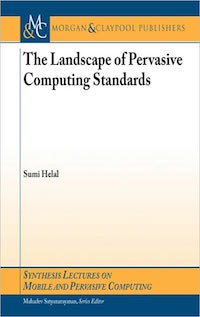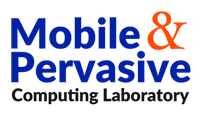Books

The Landscape of Pervasive Computing Standards
Sumi Helal
Morgan & Claypool Publishers
June 2010.
ISBN 1598299263
Why this Book?
Like it or not, tens of billions of lines of COBOL code are still in use today. Invented in 1959 by a group of computer professionals, COBOL empowered developers worldwide to program the mainframe and create applications still in existence today. Undoubtedly, COBOL owes much of its success to its standardization, which started with the American National Standard in 1968. Yet these days, standards alone won't lead to success. With the invention of the PC and emergence of the network, we realized we also need new concepts and capabilities to program networks of computers. Standards such as TCP/IP and IEEE 802 played a major role in transforming the first computer network concept (Arpanet) to the Internet we know today. However, we also had to invent new computing models such as the client-server model, transactions, distributed objects, Web services, disconnected operation, and computing grids. Furthermore, we had to invent various middleware to support these emerging models, hiding the underlying system's complexity and presenting a more programmable view to software and application developers.
Today, with the advent of sensor networks and pinhead-size computers, we are moving much closer to realizing the vision of ubiquitous and pervasive computing. However, as we begin to create pervasive spaces, we must think ahead to consider how we will program them, just as we successfully programmed the mainframe and, later on, the Internet.
About this Book ....
This lecture presents a first compendium of established and emerging standards in pervasive computing systems. The lecture explains the role of each of the covered standards and explains the relationship and interplay among them. Hopefully, the lecture will help piece together the various standards into a sensible and clear landscape.
The lecture is a digest, reorganization, and a compilation of several short articles that have been published in the “Standards and Emerging Technologies” department of the IEEE Pervasive Computing magazine. The articles have been edited and
shortened or expanded to provide the necessary focus and uniform coverage depth.
There are more standards and common practices in pervasive systems than the lecture could cover. However, systems perspective and programmability of pervasive spaces, which are the main foci of the lecture, set the scope and determined which standards should be included. The lecture explains what it means to program a pervasive space and introduces the new requirements brought about by pervasive computing. Among the standards the lecture covers are sensors and device standards,
service-oriented device standards, service discovery and delivery standards, service gateway standards, and standards for universal interactions with pervasive spaces. In addition, the emerging sensor platform and domestic robots technologies are covered and their essential new roles explained. The lecture also briefly covers a set of standards that represents an ecosystem for the emerging pervasive healthcare industry.
Audiences who may benefit from this lecture include (1) academic and industrial researchers working on sensor-based, pervasive, or ubiquitous computing R&D; (2) system integrator consultants and firms, especially those concerned with integrating sensors, actuators, and devices to their enterprise and business systems; (3) device, smart chips, and sensor manufacturers; (4) government agencies; (5) the healthcare IT and pervasive health industries; and (6) other industries such as logistics, manufacturing, and the emerging smart grid and environment sustainability industries.
Table of Contents
ACKNOWLEDGEMENTS 6
CHAPTER 1. INTRODUCTION 7
1.1 LIMITATIONS OF INTEGRATED ENVIRONMENTS 8
1.1.1 Nonscalable integration 8 1.1.2 Closed-world assumptions 9
1.1.3 Fixed-point concepts 10
1.1.4 Lack of Programmability 10
1.2 THE NEED FOR MIDDLEWARE AND STANDARDS 11
1.2.1 Self-integration 11
1.2.2 Semantic exploitation 14
1.3 PROGRAMMABILITY 15
1.3.1 Service Orientation 16
1.3.2 Who should program a pervasive space? 17
1.3.3 Programming models 17
1.3.4 Integrated Development Environments (IDE)? 18
1.4 This Lecture 19
CHAPTER 2. SENSOR AND DEVICE STANDARDS 22
2.1 Different standards 23
2.1.1 ECHONET 24
2.1.2 IEEE 1451 24
2.1.3 SensorML 25
2.1.4 Device Kit 25
2.1.5 DDL 26
2.2 From plaintext to markup language 26
2.3 Bridging the physical and digital world 27
2.4 Different scopes for different standards 29
2.5 Dissecting Devices 32
2.5.1 Object-oriented perspective 32
2.5.2 Data-oriented perspective 33
2.5.3 Modular perspective 33
CHAPTER 3. SERVICE-ORIENTED DEVICE ARCHITECTURE (SODA) 36
3.1 Modeling Devices as Services 37
3.2 How a Serice-Oriented Architecture Can Help 39
3.3 The SODA Architecture 42
CHAPTER 4. SENSOR PLATFORMS 46
4.1 The Birth of the Sensor Platform 47
4.1.1 Early Requirements of Sensor Platforms 47
4.1.2 Berkeley Motes 49
4.2 Sensor Platforms for Smart Spaces 50
4.2.1 Phidgets: Physical Widgets 52
4.2.2 The Atlas Sensor Platform 54
CHAPTER 5. SERVICE DISCOVERY AND DELIVERY STANDARDS 58
5.1 SERVICE DISCOVERY PROTOCOLS 59
5.2 JINI 60
5.2.1 Leasing in Jini63
5.2.2 Distributed programming in Jini 63
5.3 UNIVERSAL PLUG AND PLAY 64
5.3.1 Joining and discovery in UPnP 64
5.3.2 UPnP service description 66
5.3.3 Automatic configuration of IP 66
5.4 SERVICE LOCATION PROTOCOL (SLP) 67
5.5 BLUETOOTH SDP 69
5.6 SDP SUCCESSES / FAILURES (2000-2010) 69
CHAPTER 6. THE OPEN SERVICES GATEWAY INITIATIVE (OSGi ) 73
6.1 THE FRAMEWORK 74
6.2 SPECIFICATIONS 77
6.3 DEVELOPMENT TOOLKITS 78
6.3.1 ProSyst mBedded Builder 78
6.3.2 Java Embedded Server 78
6.3.3 IBM SMF Bundle Developer 79
6.4 ADOPTION AND PRODUCTS 81
6.5 CASE STUDY: THE GATOR TECH SMART HOUSE 83
CHAPTER 7. UNIVERSAL INTERFACES 84
7.1 THE STANDARDS 84
7.2 TARGETS AND URCS 86
7.3 HOW THE STANDARDS WORK TOGETHER 88
7.4 ARCHITECTURE 90
7.5 CONFORMITY 91
7.6 MEETING A GROWING MARKET’S NEEDS 92
7.6.1 Challenges 93
7.6.2 Toward solutions 94
7.7 THE UNIFIED WEB 96
7.8 DESKTOP BROWSING ON MOBILE DEVICES 97
7.9 RICH MEDIA 97
7.10 THE BROWSER UI: DYNAMIC MENU TECHNOLOGY 99
7.10.1 Benefits 100 7.10.2 Implementation 103
7.11 UNIVERSAL INTERACTION TECHNOLOGIES 107
7.12 UNIVERSAL UI LANGUAGES 109 7.12.1 W3C XForms 109
7.12.2 INCITS/V2 URC standards 111
7.12.3 UIML, XIML, and PUC 114
7.13 UI REMOTING 115
7.13.1 UPnP RUI 116
7.13.2 Jini Proxy Architecture 117
CHAPTER 8. ROBOTIC COMPANIONS FOR SMART SPACE INTERACTIONS 122
8.1 Existing User Interfaces in Smart Spaces 123
8.2 Robots as Smart Space Butlers 124
8.3 Comparing Robotic Companions 131
8.4 The Case for Robotic Companions 132
CHAPTER 9. CONTINUA: AN INTEROPERABLE PERSONAL HEALTH ECHOSYSTEM 134
9.1 Interoperability Through Industry Standards 134
9.2 The Reference Architecture 137
9.3 The Big Picture 141
REFERENCES
